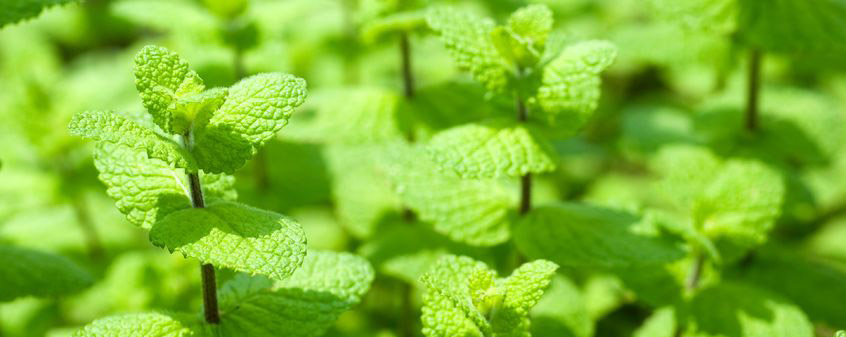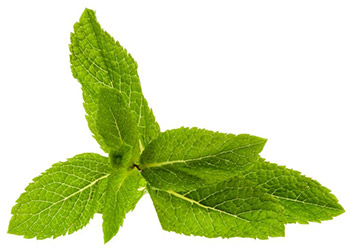Spearmint Essential Oil
Mentha spicata

Description
I use Spearmint Essential Oil either as a complete substitute for Peppermint Essential Oil or to blend with the peppermint to tone it down whenever I'm concerned that the menthol in peppermint may overpower a blend.

Spearmint Essential Oil is a somehwat more subtle oil than peppermint because it contains significantly less menthol, but can be used for similar fragrancing applications. I especially enjoy incorporating Spearmint Oil into blends intended for easing headaches or stress.
The fresh, clean aroma of Spearmint Essential Oil blends well with other essential oils including peppermint, rosemary, basil, bay laurel, orange and lavender.
Emmotionally, I find Spearmint Essential Oil to invigorating. Mentally, it helps me to move torwards "fresh" ideas.
Spearmint Essential Oil Benefits and Uses
- Asthma
- Exhaustion
- Fever
- Flatulence
- Headache
- Nausea
- Scabies
- Vertigo
Source: Julia Lawless, The Encyclopedia of Essential Oils (Updated Edition) (London: Harper Thorsons, 2014), 140-141.
Botanical Name
Plant Family
Common Method of Extraction
Steam Distilled
Plant Part Typically Used
Color

Clear
Consistency
Thin
Perfumery Note
Top/Middle
Strength of Initial Aroma
Medium
Aromatic Description
Spearmint Essential Oil smells minty, fresh and perhaps slightly fruity in aroma. It is somewhat less intense than peppermint.
Sustainability and Conservation Status
Least Concern
Source: https://www.iucnredlist.org/species/164464/42395980
To learn more about the conservation status of essential oil bearing plants and how to use the IUCN Red List of Threatened Species, please refer to AromaWeb's Guide to Essential Oils and Sustainability.
Major Constituents
- (-)-Carvone
- (+)-Limonene
- (Z)-Dihydrocarvone
- 3-Octanol
- Methone
- 1,8-Cineole
See Essential Oil Safety for more complete list of typical constituents.
Source: B.M. Lawrence, Essential Oils 1988-1991 (Wheaton: Allured Publishing, 1995), 20. Source cited in Robert Tisserand and Rodney Young, Essential Oil Safety (Second Edition. United Kingdom: Churchill Livingstone Elsevier, 2014), 427.
Spearmint Essential Oil Safety Information
Tisserand and Young report that Spearmint Essential Oil is a potential mucous membrane irritant. They also caution that there is a low risk of skin sensitization and recommend a dermal maximum of 1.7%. Reading Tisserand and Young's full profile is recommended. [Robert Tisserand and Rodney Young, Essential Oil Safety (Second Edition. United Kingdom: Churchill Livingstone Elsevier, 2014), 427-248.]
General Safety Information
Do not take any oils internally and do not apply undiluted essential oils, absolutes, CO2s or other concentrated essences onto the skin without advanced essential oil knowledge or consultation from a qualified aromatherapy practitioner. For general dilution information, read AromaWeb's Guide to Diluting Essential Oils. If you are pregnant, epileptic, have liver damage, have cancer, or have any other medical problem, use oils only under the proper guidance of a qualified aromatherapy practitioner. Use extreme caution when using oils with children and be sure to first read the recommended dilution ratios for children. Consult a qualified aromatherapy practitioner before using oils with children, the elderly, if you have medical issues or are taking medications. Before using this or any essential oil, carefully read AromaWeb's Essential Oil Safety Information page. For in-depth information on oil safety issues, read Essential Oil Safety by Robert Tisserand and Rodney Young.
Shelf Life
Important Information About the Profiles
The essential oil information provided on AromaWeb is intended for basic educational purposes only. The references to safety information, test results, constituents and percentages is generalized information. Essential oils can vary greatly in composition. The data is not necessary complete and is not guaranteed to be accurate. The essential oil photos are intended to represent the typical and approximate color of each essential oil. However, essential oil composition and color can vary based on harvesting, distillation, age of the essential oil and other factors. Profiles for several CO2 Extracts and absolutes are included within the directory, and are denoted as such.
